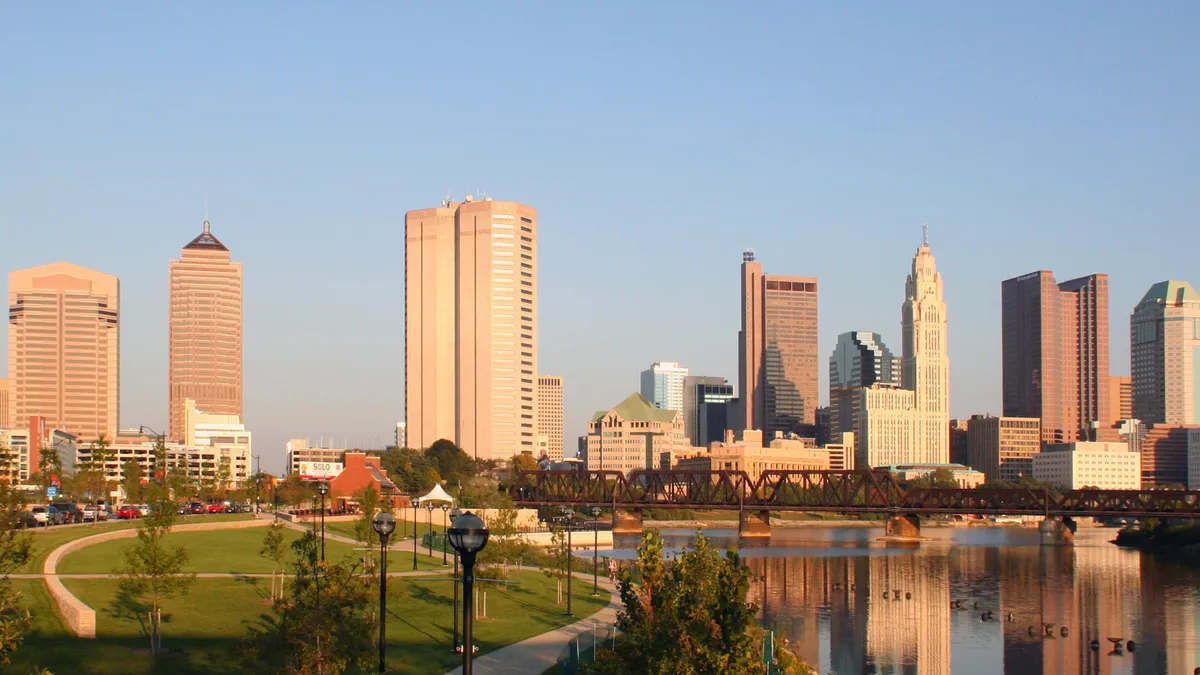Dive Brief:
- Columbus, OH residents have purchased 3,323 electric vehicles (EV) over the past three years, exceeding its EV adoption goals created in 2016 amid a $10 million grant from the Paul G. Allen Family Foundation. The grant followed the city's win of the $40 million U.S. Department of Transportation (USDOT) Smart City Challenge.
- Only 0.4% of cars sold in the Columbus-area were EVs as of 2016, a figure that has now reached over 1.8%. Additionally, over 20% of consumers in the region say they are likely to purchase an EV in the future, pointing to potentially even more growth to come.
- Three key programs are credited with helping the city surpass its consumer EV adoption goal:
- Providing free chargers to business and public spaces
- Teaming up with large employers to encourage EV education
- Working with original equipment manufacturers (OEM) and local "electrified dealers" to create more available models in Central Ohio
Dive Insight:
Columbus has always been a key test market for innovation, Smart Columbus director Jordan Davis told Smart Cities Dive. Now, the region can be a potential model for other cities seeking to accelerate EV adoption while boosting consumer perceptions of the technology.
To encourage EV adoption, Smart Columbus teamed up with private employers, including 70 "Acceleration Partners" who have helped influence the local workforce to adopt EVs. Almost 12,000 EV test drives have occurred as a result to date, and 50 local executives have agreed to personally drive EVs. American Electric Power Ohio (AEP) also invested $9.5 million in electric chargers across the region to help businesses install chargers at their properties.
Additionally, Smart Columbus worked with auto dealers and manufacturers to encourage the delivery of more EVs to Central Ohio, as OEMs typically send many of their EV supplies to the coasts, according to a Smart Columbus spokesperson. Thirty-five "Electrified Dealers" in the region have trained associates on how to sell EVs.
Davis credited other EV-forward cities and countries with helping to shape Smart Columbus' EV playbook. "We've benefited from so many other communities who were at this decades ago in a really robust way, like Portland [OR] was and Seattle," she said.
Smart Columbus officials even visited Oslo, Norway — a leader in the EV space — to learn first-hand "what the future of electrification could look like," according to Davis.
Columbus' EV adoption comes as the city slowly lifts the shelter-in-place orders that resulted in dramatic nationwide greenhouse gas (GHG) reductions. One way to potentially keep GHG levels from returning to their pre-coronavirus levels could be via transportation electrification, Davis said.
Other cities could also look to Columbus’ electrification efforts as they seek to curb GHG emissions. In fact, city officials shared this week that the Columbus area exceeded its environmental goals made three years ago under the USDOT grant. Smart Columbus also launched a "digital capstone" site this week to help other mid-sized cities potentially replicate that success, of which EV adoption is a key factor.
Another aspect of coronavirus recovery for Columbus, and for many other cities, will be to prevent what some experts fear could be "private car revenge," or a surge of individuals turning to cars in lieu of public transit or other shared mobility modes. In Columbus, about 2% of the population commutes via public transit, according to Davis, while over 83% commute via single-occupancy vehicles. In efforts to push EV adoption among consumers, the city has actively tried to strike the balance of promoting EV ownership while encouraging shared mobility, Davis said.
The Central Ohio Transit Authority has also made a commitment to purchase and introduce electrification into its fleet for the first time with 10 buses. And Columbus Yellow Cab, a locally operated transportation network company (TNC), also converted some of its vehicles to electric and partnered with EV charging company Greenlots to help expansion.
Despite massive steps forward, there's still progress to be made in Columbus. Looking ahead, Smart Columbus sees the "biggest area of opportunity" in bringing EVs to low-income neighborhoods, which are also likely the areas where the impacts of carbon emissions are hurting residents the most, Davis said.
To keep up with all of our coverage on how the new coronavirus is impacting U.S. cities, visit our daily tracker.
















